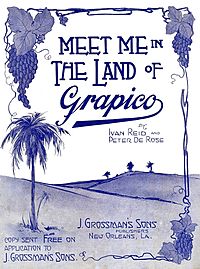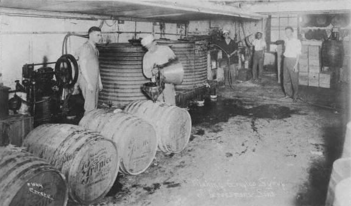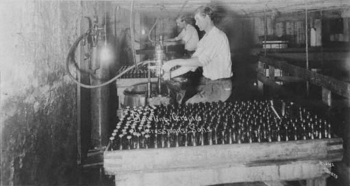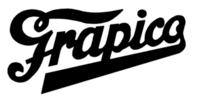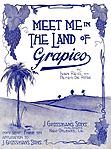Grapico facts for kids
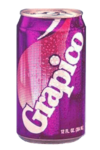
A can of Grapico
|
|
| Type | Soft drink |
|---|---|
| Manufacturer | Sun Fresh Beverages |
| Distributor | Buffalo Rock |
| Country of origin | United States (New Orleans, Louisiana), currently Birmingham, AL |
| Introduced | 1916 |
| Colour | Purple |
| Flavour | Artificial Grape |
| Variants | Diet Grapico |
| Related products | Welch's Grape Soda Grape Nehi Grapette Grape Crush Stewart's Grape Soda NuGrape |
| Website | Grapico.com |
Grapico is a popular purple-colored soft drink with a grape taste. It doesn't have caffeine and is sold mostly in the Southeastern U.S.. It first came out in 1916. For a long time, people thought Grapico had real grape juice, but it actually used artificial flavors.
In 1929, the company that made Grapico at the time, Pan American Manufacturing Company, lost the right to use the name "Grapico" for their artificial grape drink. This was because they kept making it seem like the drink had real grape juice when it didn't.
However, the Grapico brand continued through an Alabama businessman named R. R. Rochell. He had been selling bottled Grapico in Alabama since 1917. By 1929, Rochell was selling Grapico in several states, including Alabama, Florida, Georgia, Mississippi, and Louisiana.
Rochell officially registered the name "Grapico" as a federal trademark in 1940. This gave his company, Grapico Company of America, the right to use the name across the United States. Today, Grapico is made by Buffalo Rock, a company based in Birmingham, Alabama.
Contents
The Story of Grapico: A Sweet History
Grapico was first sold in 1914 in New Orleans, Louisiana. It was created by a business called J. Grossman's Sons. In 1917, a businessman named R. R. Rochell from Birmingham, Alabama, started buying Grapico syrup from J. Grossman's Sons. He would bottle it and sell it in Alabama. This made him the first company to buy the syrup in large amounts.
Today, the company that distributes Grapico, Buffalo Rock, bought the Grapico business in 1981. The original Grapico line from J. Grossman's Sons ended in 1929. So, the Grapico we know today really started with R. R. Rochell's company in Birmingham, Alabama, back in 1917.
Grapico's Early Days with J. Grossman's Sons
J. Grossman's Sons was a business that had been around in New Orleans, Louisiana, since at least 1884. By the early 1900s, two brothers, Adolph and Isidore Grossman, were running the business.
J. Grossman's Sons started making Grapico in 1914. At first, Grapico was a syrup that, when mixed with soda water, looked, smelled, and tasted like a real grape drink. But it was artificially colored and flavored. It had almost no real grape juice in it.
Before 1916, J. Grossman's Sons asked famous jazz composers Peter DeRose and Ivan Reid to write a song about Grapico. DeRose, who later became very famous, wrote a song called Meet Me in the Land of Grapico. This song was a sweet ballad that imagined a magical "Land of Grapico" where love lasted forever. The song and its cover showed a grape vine-covered arbor, even though Grapico didn't have real grape juice. J. Grossman's Sons published the song in 1916 and gave it away for free.
In 1917, R. R. Rochell's Grapico Bottling Works in Birmingham, Alabama, started buying Grapico syrup to bottle and sell. In the same year, another company in Laurel, Mississippi, also started bottling and selling Grapico.
By 1919, Grapico was doing very well. In 1920, the demand for soft drinks grew a lot because of prohibition against alcohol in the United States. Grapico was so popular that it was even listed in a Louisiana law for items to be taxed, alongside other famous drinks like Coca-Cola and RC Cola.
In June 1922, Grapico Bottling Works ran an advertisement that linked the artificially flavored drink to real grape juice. They held a writing contest asking why people preferred "Sparkling Grapico" over fresh grapes. The ad claimed Grapico was made from "Pure Grape Juice with pure sugar and carbonated water" and had "no coloring or preservatives." This wasn't true, but it was similar to what J. Grossman's Sons put on their syrup barrels.
The Problem with Deceptive Advertising
From the very beginning in 1914, J. Grossman's Sons made it seem like Grapico was made with real grape juice. This helped them compete with real grape juice makers like Welch Grape Juice Co. and gave them an edge over other fake grape drinks. The problem was that Grapico was an artificial grape drink with no real grape juice.
In May 1926, J. Grossman's Sons sold their Grapico formula and all rights to Pan American Manufacturing Co., Inc. This company had been making flavors and syrups since 1911. Pan American continued to make Grapico syrup and sell it to wholesale customers like Rochell's Grapico Bottling Works.
Pan American also continued to make Grapico seem like it had real grape juice. They used ads with pictures of grape vineyards and bunches of grapes. Their bottles even had a grape bunch molded into the glass. Since the drink looked, tasted, and smelled like grape juice, all these things together made people believe Grapico was made of pure grape juice.
In July 1928, the Federal Trade Commission (FTC) stepped in. The FTC is a government agency that protects consumers from unfair business practices. They charged Pan American with using unfair methods and deceptive practices. Pan American tried to change their labels, but it was too late. In 1929, Pan American lost the right to use the word "Grapico" for their artificial grape drink. However, their wholesale customers, like R. R. Rochell, were not affected by this order.
Grapico Under R. R. Rochell
R. R. Rochell was a successful businessman in Birmingham, Alabama. He started selling bottled Grapico in Alabama in 1917 and then in Mississippi in 1918. In June 1920, Rochell's Grapico Bottling Works officially became a company in Alabama.
By 1922, R. R. Rochell's Grapico had expanded into the Florida soft drink market. After the Mississippi Grapico company closed in 1925, and Pan American was stopped from using the "Grapico" name, Rochell became the only supplier of bottled Grapico in Alabama, Florida, Georgia, Mississippi, and Louisiana by 1929.
Just before he passed away in 1940, R. R. Rochell applied for a federal trademark for Grapico. The trademark was granted, giving his company the national rights to the Grapico name. In that same year, Grapico was sold with the slogan:
In 1955, Grapico Company of America tried to add an orange-flavored drink called Orangico. This drink was supposed to have real orange juice. However, Orangico didn't sell well, and its federal trademark eventually expired in 1999.
In September 1981, the rights to the Grapico brand name were bought by Buffalo Rock. Buffalo Rock is an independent Pepsi bottler that started in Birmingham, Alabama, in 1901. Both Buffalo Rock and R.R. Rochell's businesses had been in Birmingham since the early 1900s.
Between 1981 and 1988, Grapico was mainly sold in Alabama, Florida, and Georgia. In August 1988, Buffalo Rock announced they would expand Grapico's distribution to the rest of the Southeastern United States. This announcement came with new, more modern Grapico packaging. By June 1990, Grapico was also being sold in South Carolina.
Buffalo Rock brought back the Orangico name in 1999, but this time it was for an artificial orange syrup, not a real orange juice drink. In 2005, Buffalo Rock also introduced Diet Grapico. Today, Grapico is produced by Buffalo Rock at its facility in Columbus, Georgia.
In 2012, a cupcake shop in Homewood even created a Grapico cupcake at the request of Buffalo Rock!
Grapico in Popular Culture
Grapico has appeared in several books! It's mentioned in Fried Green Tomatoes at the Whistle Stop Cafe, a best-selling novel from 1987 by Fannie Flagg.
In Anne George's 1996 novel Murder on a Bad Hair Day: A Southern Sisters Mystery, and in the 2004 novel Making Waves by Cassandra King, there's a drink called the "Ex-girlfriend." It's made by mixing Grapico with Absolut Peppar jalapeño flavored vodka. It's called the Ex-girlfriend because, as the books say, "it's sweet and seems like a good idea, but eventually it's going to burn you and make you sick." Also, Grapico mixed with coconut rum is called a "grapicolada."
Gallery
- Meet Me in the Land of Grapico
-
Grapico manufacturing plant in 1917


